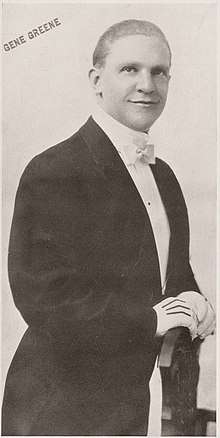Gene Greene
| Gene Greene | |
|---|---|
 | |
| Background information | |
| Birth name | Eugene Delbert Greene |
| Born | June 9, 1877 |
| Died |
April 5, 1930 (aged 52) New York City |
| Genres | Vocal jazz, ragtime |
| Occupation(s) | Singer |
| Years active | 1911–1930 |
Eugene Delbert Greene (June 9, 1877 – April 5, 1930) was an American vaudeville and ragtime singer. He was one of the first to use scat singing techniques.
Career
Greene was born in Aurora, Illinois, and moved to Chicago as a young child. He began his professional career in the late 1890s with Blanche Werner, whom he married. They performed in vaudeville as Manjonita and Eugene, then as Greene & Werner.
From 1911–1917, he made five recordings of "King of the Bungaloos", which was his most popular song. Nicknamed "The Ragtime King", he employed scat singing techniques on this song.[1][2] His other songs included "The Chinese Blues" and "Alexander's Got a Jazz Band Now". While on a two-year tour of Europe, Blanche Werner died in 1912. Greene continued to perform, making about 64 recordings from 1912–1913 before returning to the U.S. He retired to Grand Rapids, Michigan, and ran a restaurant. He tried to sing again in New York City but died of a heart attack backstage.[1]
Greene was associated with the song "I Didn't Raise My Boy to Be a Soldier" by Alfred Bryan and Al Piantadosi. This song was one of the few antiwar music-hall songs during the First World War. This reflected the views of Chicago's large German population at the time, but the song was also popular and controversial in Britain.
"King of the Bungaloos" appeared on Pop Music: The Early Years 1890–1950 as part of Sony's Soundtrack for a Century box set.[3]
See also
References
- 1 2 Yanow, Scott. "Gene Greene". AllMusic. Retrieved 5 December 2017.
- ↑ Jasen, David A. (2007). Ragtime: An Encyclopedia, Discography, and Sheetography. Taylor & Francis. pp. 262–. ISBN 978-0-415-97862-0. Retrieved 5 December 2017.
- ↑ Muir, Peter C. (2010). Long Lost Blues: Popular Blues in America, 1850–1920. Urbana, Illinois: University of Illinois Press. ISBN 978-0-252-07676-3.